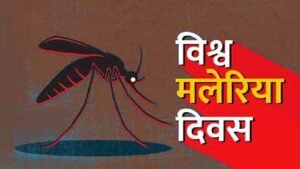
विश्व मलेरिया दिवस…
विश्व स्वास्थ्य संगठन हर साल 25 अप्रैल को विश्व मलेरिया दिवस मनाता है. विश्व मलेरिया दिवस की स्थापना मई 2007 में 60वें विश्व स्वास्थय सभा के सत्र के दौरान की गई थी. विश्व मलेरिया दिवस की स्थापना से पूर्व 25 अप्रैल 2001 से मनाये जाने वाले अफ्रिका मलेरिया दिवस के 01 वर्ष पश्चात अबुजा में घोषणा की गई थी. पूरी दुनिया में लगभग 106 देश हैं और इन देशों की आबादी करीब 07.52 अरब है.
विश्व स्वास्थ्य संगठन (डब्ल्यूएचओ) के अनुसार, 2017 में पूरी दुनिया मलेरिया के कुल मामलों में से 80 प्रतिशत मामले भारत और 15 प्रतिशत सहारा (अफ्रीकी) देशों से थे जबकि 2018 की रिपोर्ट के अनुसार, भारत में मलेरिया के मामलें में 24 प्रतिशत की गिरावट आई है लेकिन, ओड़िसा, महारष्ट्र समेत कुछ अन्य राज्यों में अभी सफलता के बड़े प्रयासों की जरूरत है.
रिपोर्ट के अनुसार, भारत में 1.25 अरब लोग इस मच्छर जनित बीमारी की चपेट में आने की कगार पर खड़े थे. पूरी दुनिया में मलेरिया के करीब आधे मामले पांच देशों से सामने आए जिनमें नाइजीरिया (25 प्रतिशत), कांगो लोकतांत्रिक गणराज्य (11 प्रतिशत), मोजाम्बिक (05 प्रतिशत) और भारत एवं युगांडा से चार-चार प्रतिशत मामले देखे गए हैं. रिपोर्ट के अनुसार, मलेरिया से हर साल लगभग 660,000 लोगों की जान चली जाती है.
मलेरिया एक ऐसी बीमारी है जो मलेरिया मच्छरों से फैलती है. मलेरिया मच्छर जब मानव के शरीर के सम्पर्क में आते हैं तो मानव को बहुत तेज बूखार (पसीना, ठंड और कँपकँपी, सिरदर्द, माँसपेशियों में दर्द, थकान, जी मचलना, उल्टी, दस्त) आने लगता है.
मलेरिया एक प्रकार के परजीवी प्लाजमोडियम से फैलने वाला रोग है, जिसका वाहक मादा एनाफिलीज मच्छर होता है. जब संक्रमित मादा एनाफिलीज मच्छर किसी व्यक्ति को काटती है तो उसके खून की नली में मलेरिया के रोगाणु फैल जाते हैं. संक्रमण फैलने से उसमें मलेरिया के लक्षण दिखाई देने लगते हैं.
यह रोगाणु मानव के लीवर की कोशिकाओं में पहुंच कर लाल रक्त कोशिकाओं पर हमला करती है जिसके कारण कोशिका टूटने लगती है. दूसरी तरफ लीवर में रोगाणुओं की संख्या लगातार बढती रहती है.
बताते चलें कि, मादा मच्छर ही इंसान को काटती है जबकि नर मच्छर कभी नहीं काटता, मादा मच्छर को अंडे पैदा करने के लिए प्रोटीन की जरुरत होती है इसलिए खून चूसती है. मादा मच्छर एक बार खून चूसने के बाद लगभग 02 दिनों तक आराम करते हैं. मादा मच्छर एक बार में करीब 300 से ज्यादा अंडे देती है, अंडे से निकलने के बाद मच्छर अपने शुरुआती 10 दिन पानी में ही बिताते हैं.
मलेरिया से बचाब कैसे करें…
- घर के अंदर व बाहर मच्छर मारने वाली दवाई छिड़कें.
- पानी इकठ्ठा नहीं होने दें. पानी इकठ्ठा होने से मच्छर के पनपने का खतरा होता है.
- जहां झाडियां हो वहां नहीं जाना चाहिए चुकिं, वहां बहुत मच्छर होते हैं.
- हल्के रंग के पुर कपड़े पहनना चाहिए.
- घर के दरवाजों और खिड़कियों पर जाली लगवाएं.
- सोने के समय मच्छरदानी का प्रयोग करना चाहिए.
- अगर आपको मलेरिया हो जाय तो तुरंत ही चिकित्सक से मिलना चाहिए.
========== ========= ===========
World Malaria Day…

The World Health Organization celebrates World Malaria Day every year on 25 April. World Malaria Day was established in May 2007 during the 60th session of the World Health Assembly. Before the establishment of World Malaria Day, it was announced in Abuja one year after Africa Malaria Day, which was celebrated from 25 April 2001. There are about 106 countries in the whole world and the population of these countries is about 07.52 billion.
According to the World Health Organization (WHO), in 2017, 80 percent of the total malaria cases worldwide were from India and 15 percent from Sub-Saharan (African) countries, while according to the 2018 report, there was a 24 percent decline in malaria cases in India. But, in some other states including Odisha, Maharashtra, bigger efforts are still needed for success.
According to the report, 1.25 billion people in India were on the verge of falling prey to this mosquito-borne disease. Nearly half of the malaria cases in the world were reported from five countries, in which Nigeria (25 percent), Democratic Republic of the Congo (11 percent), Mozambique (05 percent) and four percent each were seen from India and Uganda. According to the report, about 660,000 people die every year due to malaria.
Malaria is a disease which is spread by malaria mosquitoes. When malaria mosquitoes come in contact with the human body, the human starts having high fever (sweating, cold and shivering, headache, muscle pain, fatigue, nausea, vomiting, diarrhea).
Malaria is a disease spread by a type of parasite, Plasmodium, whose carrier is the female Anopheles mosquito. When an infected female Anopheles mosquito bites a person, malaria germs spread in his bloodstream. As the infection spreads, symptoms of malaria start appearing.
This germ reaches the human liver cells and attacks the red blood cells, due to which the cells start breaking. On the other hand, the number of microbes in the liver continues to increase.
Let us tell you that only female mosquitoes bite humans whereas male mosquitoes never bite, female mosquitoes need protein to produce eggs and hence suck blood. Female mosquitoes rest for about 02 days once they suck blood. Female mosquitoes lay more than 300 eggs at a time. After hatching, mosquitoes spend their first 10 days in water.
How to prevent malaria…
- Spray mosquito repellent inside and outside the house.
- Do not allow water to accumulate. There is a danger of mosquitoes breeding due to accumulation of water.
- One should not go where there are bushes because there are many mosquitoes there.
- Light colored pure clothes should be worn.
- Install mesh on the doors and windows of the house.
- Mosquito net should be used while sleeping. If you get malaria, you should consult a doctor immediately.





